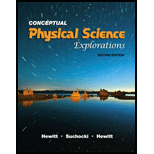
Are induced dipoles permanent?
Whether induced dipoles are permanent or not?
Answer to Problem 20RQ
No, induced dipoles are temporary.
Explanation of Solution
The atoms of the same elements or the atoms of elements having very less electronegativity difference tend to share the electrons mutually for the covalent bond formation. The mutual sharing of negative species that is electrons between the atoms of a slight electronegativity difference creates a dipole and generates a polar molecule. The dipole is a charge separation of a covalent molecule.
A polar molecule is formed where the atoms with slightly higher electronegativity tend to attract electrons more towards it and gain a partial negative charge while the other element presents with slightly lesser electronegativity gains a partial positive charge. A non-polar molecule is formed when the equal and proportional distribution of negative species electrons is present between the atoms of a covalent molecule.
When a non-polar molecule comes in contact with a polar molecule, the polar molecule tends to induce the polarity on to the non-polar molecule. This results in temporary uneven distribution of electrons in a non-polar molecule and shows the phenomenon of induced dipole interaction.
Conclusion:
Therefore, induced dipoles are not permanent they are temporary attraction between a polar and a non-polar molecule.
Chapter 18 Solutions
Conceptual Physical Science Explorations
Additional Science Textbook Solutions
Modern Physics
Conceptual Integrated Science
College Physics: A Strategic Approach (3rd Edition)
The Cosmic Perspective Fundamentals (2nd Edition)
Conceptual Physical Science (6th Edition)
Physics for Scientists and Engineers: A Strategic Approach with Modern Physics (4th Edition)
 College PhysicsPhysicsISBN:9781305952300Author:Raymond A. Serway, Chris VuillePublisher:Cengage Learning
College PhysicsPhysicsISBN:9781305952300Author:Raymond A. Serway, Chris VuillePublisher:Cengage Learning University Physics (14th Edition)PhysicsISBN:9780133969290Author:Hugh D. Young, Roger A. FreedmanPublisher:PEARSON
University Physics (14th Edition)PhysicsISBN:9780133969290Author:Hugh D. Young, Roger A. FreedmanPublisher:PEARSON Introduction To Quantum MechanicsPhysicsISBN:9781107189638Author:Griffiths, David J., Schroeter, Darrell F.Publisher:Cambridge University Press
Introduction To Quantum MechanicsPhysicsISBN:9781107189638Author:Griffiths, David J., Schroeter, Darrell F.Publisher:Cambridge University Press Physics for Scientists and EngineersPhysicsISBN:9781337553278Author:Raymond A. Serway, John W. JewettPublisher:Cengage Learning
Physics for Scientists and EngineersPhysicsISBN:9781337553278Author:Raymond A. Serway, John W. JewettPublisher:Cengage Learning Lecture- Tutorials for Introductory AstronomyPhysicsISBN:9780321820464Author:Edward E. Prather, Tim P. Slater, Jeff P. Adams, Gina BrissendenPublisher:Addison-Wesley
Lecture- Tutorials for Introductory AstronomyPhysicsISBN:9780321820464Author:Edward E. Prather, Tim P. Slater, Jeff P. Adams, Gina BrissendenPublisher:Addison-Wesley College Physics: A Strategic Approach (4th Editio...PhysicsISBN:9780134609034Author:Randall D. Knight (Professor Emeritus), Brian Jones, Stuart FieldPublisher:PEARSON
College Physics: A Strategic Approach (4th Editio...PhysicsISBN:9780134609034Author:Randall D. Knight (Professor Emeritus), Brian Jones, Stuart FieldPublisher:PEARSON





